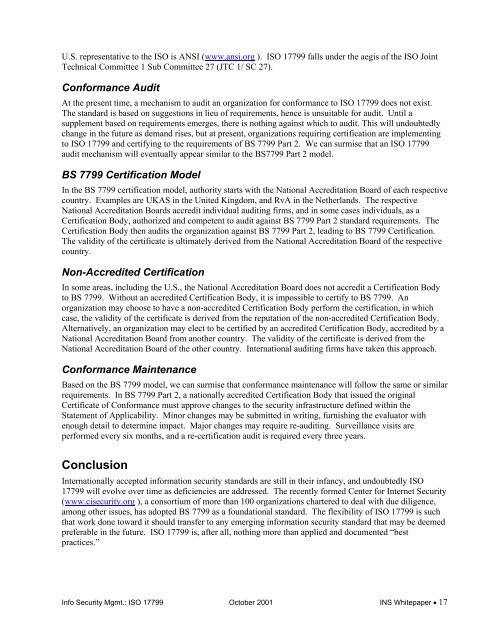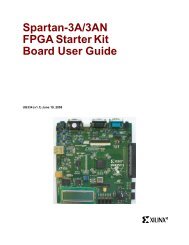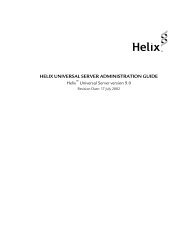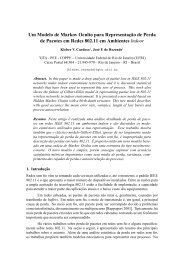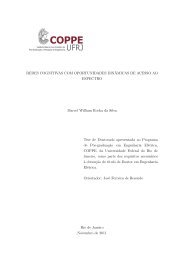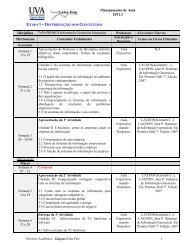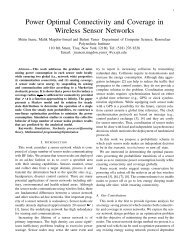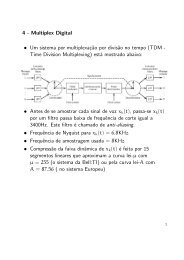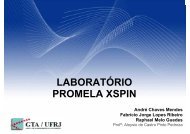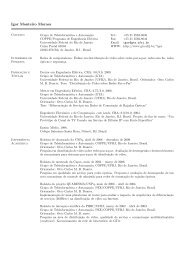Information Security Management: Understanding ISO 17799 - GTA
Information Security Management: Understanding ISO 17799 - GTA
Information Security Management: Understanding ISO 17799 - GTA
- No tags were found...
You also want an ePaper? Increase the reach of your titles
YUMPU automatically turns print PDFs into web optimized ePapers that Google loves.
U.S. representative to the <strong>ISO</strong> is ANSI (www.ansi.org ). <strong>ISO</strong> <strong>17799</strong> falls under the aegis of the <strong>ISO</strong> JointTechnical Committee 1 Sub Committee 27 (JTC 1/ SC 27).Conformance AuditAt the present time, a mechanism to audit an organization for conformance to <strong>ISO</strong> <strong>17799</strong> does not exist.The standard is based on suggestions in lieu of requirements, hence is unsuitable for audit. Until asupplement based on requirements emerges, there is nothing against which to audit. This will undoubtedlychange in the future as demand rises, but at present, organizations requiring certification are implementingto <strong>ISO</strong> <strong>17799</strong> and certifying to the requirements of BS 7799 Part 2. We can surmise that an <strong>ISO</strong> <strong>17799</strong>audit mechanism will eventually appear similar to the BS7799 Part 2 model.BS 7799 Certification ModelIn the BS 7799 certification model, authority starts with the National Accreditation Board of each respectivecountry. Examples are UKAS in the United Kingdom, and RvA in the Netherlands. The respectiveNational Accreditation Boards accredit individual auditing firms, and in some cases individuals, as aCertification Body, authorized and competent to audit against BS 7799 Part 2 standard requirements. TheCertification Body then audits the organization against BS 7799 Part 2, leading to BS 7799 Certification.The validity of the certificate is ultimately derived from the National Accreditation Board of the respectivecountry.Non-Accredited CertificationIn some areas, including the U.S., the National Accreditation Board does not accredit a Certification Bodyto BS 7799. Without an accredited Certification Body, it is impossible to certify to BS 7799. Anorganization may choose to have a non-accredited Certification Body perform the certification, in whichcase, the validity of the certificate is derived from the reputation of the non-accredited Certification Body.Alternatively, an organization may elect to be certified by an accredited Certification Body, accredited by aNational Accreditation Board from another country. The validity of the certificate is derived from theNational Accreditation Board of the other country. International auditing firms have taken this approach.Conformance MaintenanceBased on the BS 7799 model, we can surmise that conformance maintenance will follow the same or similarrequirements. In BS 7799 Part 2, a nationally accredited Certification Body that issued the originalCertificate of Conformance must approve changes to the security infrastructure defined within theStatement of Applicability. Minor changes may be submitted in writing, furnishing the evaluator withenough detail to determine impact. Major changes may require re-auditing. Surveillance visits areperformed every six months, and a re-certification audit is required every three years.ConclusionInternationally accepted information security standards are still in their infancy, and undoubtedly <strong>ISO</strong><strong>17799</strong> will evolve over time as deficiencies are addressed. The recently formed Center for Internet <strong>Security</strong>(www.cisecurity.org ), a consortium of more than 100 organizations chartered to deal with due diligence,among other issues, has adopted BS 7799 as a foundational standard. The flexibility of <strong>ISO</strong> <strong>17799</strong> is suchthat work done toward it should transfer to any emerging information security standard that may be deemedpreferable in the future. <strong>ISO</strong> <strong>17799</strong> is, after all, nothing more than applied and documented “bestpractices.”Info <strong>Security</strong> Mgmt.: <strong>ISO</strong> <strong>17799</strong> October 2001 INS Whitepaper • 17


